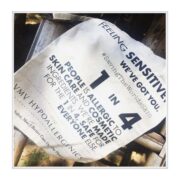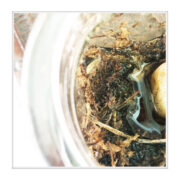Allergen.
Honey, Beeswax, Propolis:
Who doesn’t love honey? Honey — in particular raw, wild honey — is such a great treat. But honey, beeswax, propolis (related ingredients) are in published allergen lists.
In addition to being common ingredients in cosmetics, you can find honey, beeswax, propolis in nature, around bees and honeycombs, and even in less obvious things like woods and varnishes, and shoe or boot seams.
If you’ve patch tested positive for propolis, common cross reactants include balsam of peru, fragrances, cinnamon alcohol, cinnamic acid, and vanillin. Avoid carnauba wax, beeswax (it could be contaminated with propolis) and colophonium, too. And look out for other ingredients that can be problematic in propolis like benzyl cinnamate, methyl cinnamate, and benzyl salicylate.
If you have a history of sensitive skin, or suspect a sensitivity to honey, beeswax, propolis, don’t guess: random trial and error can cause more damage. Ask your dermatologist about a patch test.
References:
Regularly published reports on the most common allergens by the North American Contact Dermatitis Group and European Surveillance System on Contact Allergies (based on over 28,000 patch test results, combined), plus other studies. Remember, we are all individuals — just because an ingredient is not on the most common allergen lists does not mean you cannot be sensitive to it, or that it will not become an allergen. These references, being based on so many patch test results, are a good basis but it is always best to get a patch test yourself.
2. W Uter et al. The European Baseline Series in 10 European Countries, 2005/2006–Results of the European Surveillance System on Contact Allergies (ESSCA). Contact Dermatitis 61 (1), 31-38.7 2009
3. Wetter, DA et al. Results of patch testing to personal care product allergens in a standard series and a supplemental cosmetic series: An analysis of 945 patients from the Mayo Clinic Contact Dermatitis Group, 2000-2007. J Am Acad Dermatol. 2010 Nov;63(5):789-98.
4. Verallo-Rowell VM. The validated hypoallergenic cosmetics rating system: its 30-year evolution and effect on the prevalence of cosmetic reactions. Dermatitis 2011 Apr; 22(2):80-97
5. Ruby Pawankar et al. World Health Organization. White Book on Allergy 2011-2012 Executive Summary.
6. Misery L et al. Sensitive skin in the American population: prevalence, clinical data, and role of the dermatologist. Int J Dermatol. 2011 Aug;50(8):961-7.
7. Warshaw EM1, Maibach HI, Taylor JS, Sasseville D, DeKoven JG, Zirwas MJ, Fransway AF, Mathias CG, Zug KA, DeLeo VA, Fowler JF Jr, Marks JG, Pratt MD, Storrs FJ, Belsito DV. North American contact dermatitis group patch test results: 2011-2012.Dermatitis. 2015 Jan-Feb;26(1):49-59.
8. Warshaw, E et al. Allergic patch test reactions associated with cosmetics: Retrospective analysis of cross-sectional data from the North American Contact Dermatitis Group, 2001-2004. J AmAcadDermatol 2009;60:23-38.
9. Foliaki S et al. Antibiotic use in infancy and symptoms of asthma, rhinoconjunctivitis, and eczema in children 6 and 7 years old: International Study of Asthma and Allergies in Childhood Phase III. J Allergy Clin Immunol. 2009 Nov;124(5):982-9.
10. Kei EF et al. Role of the gut microbiota in defining human health. Expert Rev Anti Infect Ther. 2010 Apr; 8(4): 435–454.
11. Thavagnanam S et al. A meta-analysis of the association between Caesarean section and childhood asthma. Clin Exp Allergy. 2008;38(4):629–633.
12. Marks JG, Belsito DV, DeLeo VA, et al. North American Contact Dermatitis Group patch-test results, 1998 to 2000. Am J Contact Dermat. 2003;14(2):59-62.
13. Warshaw EM, Belsito DV, Taylor JS, et al. North American Contact Dermatitis Group patch test results: 2009 to 2010. Dermatitis. 2013;24(2):50-99.
14. Hausen BM. Evaluation of the main contact allergens in propolis (1995 to 2005). Dermatitis 2005;16:127-129.
15. Rajpara S, Wilkinson MS, King CM, Gawkrodger DJ, English JSC, Statham BN, Green C, Sansom JE, Chowdhury MMU, Horne HL, Ormerod AD. The importance of propolis in patch testing – a multicentre survery. Contact Dermatitis 2009; 61: 287-290.
16. Jacob SE, Chimento S, Castanedo-Tardan MP. Allergic contact dermatitis to propolis and carnauba wax from lip balm and chewable vitamins in a child. Contact Dermatitis 2008; 58: 242-243.
17. Lee SY, Lee DR, You CE, Park MY, Son SJ. Autosensitization dermatitis associated with propolis-induced allergic contact dermatitis. J Drugs Dermatol 2006; 5: 458-460.
18. Hasan T, Rantanen T, Alanko K, Harvima RJ, Jolanki R, Kalimo K, Lahti A, Lammintausta K, Lauerma AI, Laukkanen A, Luukkaala T, Riekki R, Turjanmaa K, Varjonen E, Vuorela AM. Patch test reactions to cosmetic allergens in 1995-1997 and 2000-2002 in Finland–a multicentre study. Contact Dermatitis 2005; 53: 40-45.
For more:
On the prevalence of skin allergies, see Skin Allergies Are More Common Than Ever and One In Four Is Allergic to Common Skin Care And Cosmetic Ingredients.
To learn more about the VH-Rating System and hypoallergenicity, click here.




[…] You’d need to know that if you patch tested positive to propolis, you might not be able to use beeswax, for example. Or that while green tea is sometimes categorized under “botanicals,” pure […]
[…] have no added flavor (but may have food coloring), tapioca used elsewhere might have additives like honey and artificial flavors — all top contact allergens (many flavorings are related to […]